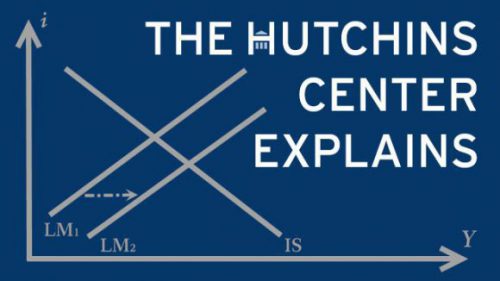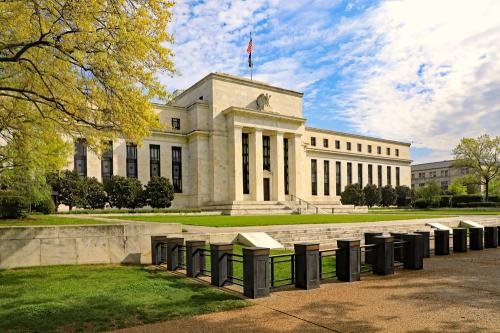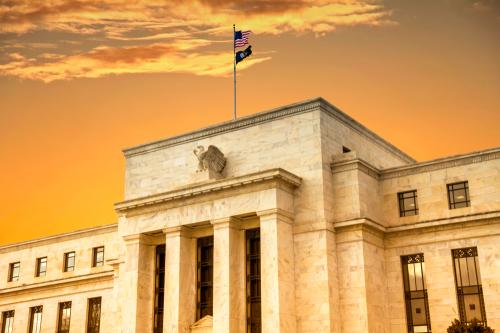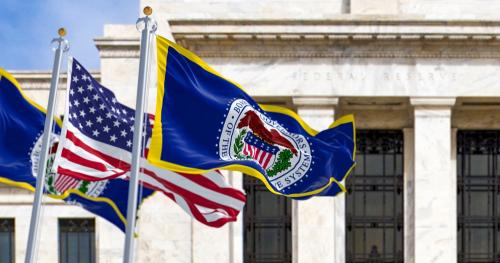The Federal Reserve’s primary tool for steering the economy is raising or lowering short-term interest rates. In recent years, however, the Fed and other central banks have embraced other tools, among them “forward guidance.” Forward guidance refers to central bank public communication about the likely future path of short-term interest rates, largely aimed at guiding financial markets. As Ben Bernanke, the former Fed chair, once quipped: Monetary policy is 98% talk and 2% action.
How does forward guidance work?
Long-term interest rates, largely set in the bond market and not directly by the Fed, are economically important because they influence the rates on mortgages and much business borrowing. But long-term rates reflect, in part, what markets expect the Fed to do with short-term rates in the future.
Here’s how Bernanke described the role of expectations in a 2013 speech:
“The public’s expectations about future monetary policy actions matter today because those expectations have important effects on current financial conditions, which in turn affect output, employment, and inflation over time. For example, because investors can choose freely between holding a longer-term security or rolling over a sequence of short-term securities, longer-term interest rates today are closely linked to market participants’ expectations of how short-term rates will evolve. If monetary policymakers are expected to keep short-term interest rates low, then current longer-term interest rates are likely to be low as well, all else being equal. In short, for monetary policy, expectations matter. Indeed, expectations matter so much that a central bank may be able to help make policy more effective by working to shape those expectations.”
What is an example of forward guidance?
In 2003, the Fed was worried that inflation was too low. Its key short-term interest rate, the federal funds rate, was already a low 1%, giving it little maneuvering room should it want to cut rates to stimulate the economy. “A very low inflation rate increases the risk that an adverse shock to the economy would be more difficult to counter effectively,” then-Fed Chair Alan Greenspan told Congress in July 2003. “Indeed, there is an especially pernicious, albeit remote, scenario in which inflation turns negative against a backdrop of weak aggregate demand, engendering a corrosive deflationary spiral.” He said the Fed would “maintain a highly accommodative stance of policy for as long as it takes to achieve a return to satisfactory economic performance”—a message that that the Fed didn’t expect to raise interest rates anytime soon.
To the Fed’s dismay, financial markets continued to anticipate that the Fed would raise rates as the economy picked up steam. “[W]hat is built into the markets now is not what we think is going to happen,” the transcript of the August 2003 FOMC (the Federal Open Market Committee, which sets interest rates) meeting records Fed governor Don Kohn telling his colleagues. He said that the FOMC statement should explicitly reinforce the message Greenspan had attempted to deliver in his congressional testimony.
“Historically, inflation has typically been higher than the Fed would like, so the FOMC has responded to strong growth by raising interest rates to forestall any inflationary impact,” Bernanke, then a Fed governor, said at the meeting, the transcript records. “This time around is different, or should be. Inflation is not a threat. Therefore, the FOMC does not need to take away the punch bowl so early in the party, so by rights interest rates should remain subdued despite the pickup in growth. Judging by federal funds futures and other indicators, however, the markets have largely missed this point and have bid up interest rates well beyond where they ought to be … to the detriment of the recovery. To the extent that we can sharpen our message that economic growth no longer implies an immediate and automatic policy tightening, we should make every effort to do so.”
Greenspan proposed adding a sentence to the FOMC’s statement: “…the Committee believes that policy accommodation can be maintained for a considerable period.” Several FOMC members objected, even though, as Greenspan assured skeptical Boston Fed President Cathy Minehan, “The definition of what constitutes ‘a considerable period’ is very flexible.”
Faced with a divided committee, Greenspan called for a show of hands. Eight of the 18 FOMC members present (one had left early to catch a plane) wanted to drop it. Greenspan decided to put it in. The Wall Street Journal headline the next day: “Fed Keeps Interest-Rate Target at 1% — Expected Decision Comes With Surprise Commitment to Continue Very Low Levels.”
With substantial prescience, Atlanta Fed President Jack Guynn, one of the eight skeptics, warned at the meeting: “My concern is that it will be the first time that, as part of the statement, we have made some very explicit comments about future policy, and I’m afraid it’s going to set a precedent.”
The “considerable period” language was repeated after every FOMC meeting until January 2004, when the statement was changed to say: “With inflation quite low and resource use slack, the Committee believes that it can be patient in removing its policy accommodation.” And in May 2004, it began to hint at rate hikes to come, saying that “the Committee believes that policy accommodation can be removed at a pace that is likely to be measured.” The FOMC raised rates by ¼ percentage point in June 2004. The “considerable period” turned out to be about one year.
What is the difference between Delphic and Odyssean forward guidance?
Statements or forecasts about the likely future direction of monetary policy are known as Delphic forward guidance, after the oracles at the Temple of Apollo at Delphi, a definition first offered by Chicago Fed President Charles Evans and co-authors. When the Fed releases its Summary of Economic Projections, for instance, policymakers signal how they believe rates may change, but they explicitly aren’t making a commitment. Delphic guidance, which has become common among central banks around the world, helps markets and the public better understand policymakers’ outlook and how they are likely to respond to changes in the economy.
Stronger, explicit commitments about the path of future policy are known as Odyssean, a reference to Odysseus binding himself to the mast in Homer’s epic poem. This form of guidance—for instance, a pledge not to raise short-term rates for “a considerable period”—can have a bigger impact on the markets and the economy than Delphic guidance. It is particularly useful when short-term interest rates are at or near the zero lower bound and the Fed is looking for other ways to stimulate the economy. But making such commitments can limit the Fed’s flexibility in responding to changes in the economy.
Why is forward guidance particularly important when short-term interest rates fall to zero?
When short-term interest rates are essentially at zero (known as the “zero lower bound”), the Fed cannot cut short-term interest rates to stimulate the economy. (Some other central banks have cut short-term rates a bit below zero, but the Fed has not.) In such instances, the Fed has turned to other ways to boost the economy, focusing more on reducing long-term rates. One tool is quantitative easing (QE), large-scale purchases of longer-term securities. Forward guidance is another. By assuring financial markets that short-term rates will remain low, the Fed hopes to keep longer-term rates from rising, even if the economy shows signs of strength.
During the global financial crisis, the Fed cut short-term rates nearly to zero in December 2008, and then used QE and various formulations of Odyssean-style forward guidance to boost the economy during the sluggish recovery. In August 2011, for instance, after considerable debate and over the dissenting votes of three members, the FOMC declared that economic conditions were “likely to warrant exceptionally low levels for the federal funds rate at least through mid-2013.” When it became clear to the FOMC that it would keep rates at zero beyond mid-2013, it altered the forward guidance in December 2012 to say that the Fed would hold off on raising rates as long as the unemployment rate was above 6.5%, inflation was projected to be no more than 2.5% over the next one to two years, and longer-term inflation expectations continued to be well anchored. In March 2014, with unemployment approaching 6.5%, the Fed altered its guidance, dropping the reference to a specific unemployment rate. The Fed raised rates from zero in December 2015 and waited another year to raise them again.
How was forward guidance used during the COVID-19 pandemic?
Even after the worst of the pandemic was over, the Federal Reserve was reluctant to raise interest rates from zero. At its September 2020 meeting, the Fed said it would leave interest rates near zero “until labor market conditions have reached levels consistent with the Committee’s assessments of maximum employment and inflation has risen to 2 percent and was on track to moderately exceed 2 percent for some time.” In a late 2020 meeting, the Fed tied the timing of lift-off from near-zero rates to the pace of asset purchases. Fed Chair Jerome Powell told markets that the Fed would give warning “well in advance” of when it began tapering the pace of asset purchases and would wait to raise rates until after that taper was complete. The Fed kept rates at zero until March 2022.
Don Kohn, the former Fed vice chair, and Gauti Eggertsson of Brown University argue in a Hutchins Center working paper that this forward guidance “created an unnecessary delay in raising rates by making the completion of asset purchases a prerequisite for raising rates and furthermore by committing to give notice far in advance on how and when asset purchases would be completed.” As a result, they argue, the Fed was slow to raise interest rates to thwart an unanticipated surge in inflation.
-
Acknowledgements and disclosures
The Brookings Institution is financed through the support of a diverse array of foundations, corporations, governments, individuals, as well as an endowment. A list of donors can be found in our annual reports published online here. The findings, interpretations, and conclusions in this report are solely those of its author(s) and are not influenced by any donation.
The Brookings Institution is committed to quality, independence, and impact.
We are supported by a diverse array of funders. In line with our values and policies, each Brookings publication represents the sole views of its author(s).








Commentary
What is forward guidance?
July 27, 2023